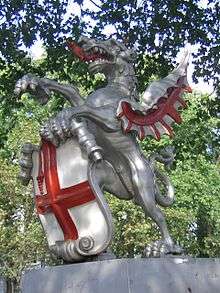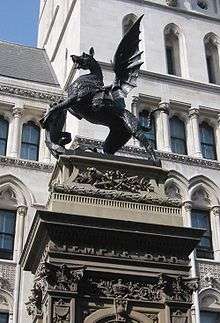Dragon boundary mark

| Wikimedia Commons has media related to City of London Dragon boundary marks. |
The dragon boundary marks are cast iron statues of dragons on metal or stone plinths that mark the boundaries of the City of London. The dragons are painted silver, with details of their wings and tongue picked out in red. The dragon stands on one rear leg, the other lifted against a shield, with the right foreleg raised and the left foreleg holding a shield which bears the City of London's coat of arms, painted in red and white. This stance is the equivalent of the rampant heraldic 'attitude' of the supporters of the City's arms.
Design
The design is based on two large dragon sculptures, 7 feet (210 cm) high, which were mounted above the entrance to the Coal Exchange on Lower Thames Street, designed by the City Architect, J. B. Bunning, and made by London founder, Dewer, in 1849. The dragons were preserved when the Coal Exchange was demolished in 1962–3. The two original statues were re-erected on 6 feet (180 cm) high plinths of Portland stone at the western boundary of the City, by Temple Gardens on Victoria Embankment, in October 1963.
The Corporation of London's Streets Committee selected the statues as the model for boundary markers for the city in 1964, in preference to the fiercer dragon by C. B. Birch at Temple Bar on Fleet Street.
Locations
Half-size replicas of the original pair of dragons made by Birmingham Guild Limited were erected at main entrances to the City of London in the late 1960s. In addition to the Birch dragon at Temple Bar, and the two original Coal Exchange statues on Victoria Embankment, there are two replicas of the Coal Exchange dragon at the south end of London Bridge, two on High Holborn near Gray's Inn Road, and single replicas on Aldgate High Street, Bishopsgate, Moorgate, Goswell Road (north of Aldersgate Street), Farringdon Street, and at the south end of Blackfriars Bridge.
Outside London, there is also a replica at Lake Havasu City, Arizona, where the 19th century London Bridge was reconstructed in 1971.
Gallery
 One of the two original statues from the Coal Exchange
One of the two original statues from the Coal Exchange Smaller replica version on Holborn
Smaller replica version on Holborn.jpg) Example in Arizona
Example in Arizona Dragon at Temple Bar, to a different design
Dragon at Temple Bar, to a different design
References
- Public sculpture of the city of London; Philip Ward-Jackson; Liverpool University Press, 2003; ISBN 0-85323-977-0, pp. 422–3
- The London encyclopaedia; Christopher Hibbert, Ben Weinreb, Julia Keay, John Keay; Pan Macmillan, 2008; ISBN 1-4050-4924-3, p. 974
- City dragon, Save our Statues, Public Monuments and Sculpture Association
- City of London Boundary Dragons, emminlondon.com